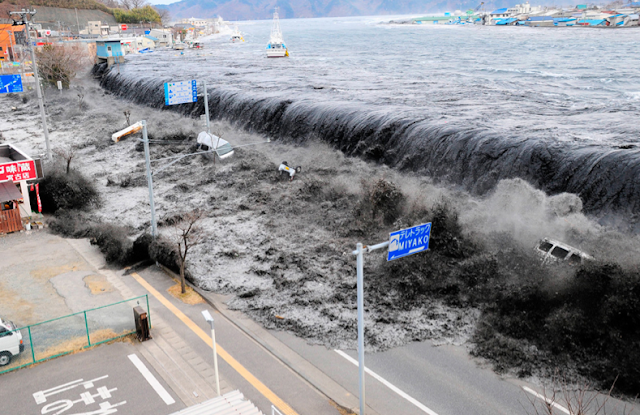Someone I know who has lived in Japan greeted me yesterday by saying, "And how are things in your little universe?" I understood exactly what she meant; the self-important worlds we build around ourselves look awfully small and fragile compared to the devastation we have seen in the past week. We can take that sentiment as the theme for this review of images.
1. The Shock
How do you express the jarring shock of an earthquake in a still image? Itsuo Inouye of the Associated Press Tokyo bureau photographed two of his fellow journalists taking shelter under a table as the world shook.
This photo, credited to Xinhua/Gamma/Rappho/Getty, shows two office workers watch smoke rise over Tokyo after the earthquake. Like them, we too are helpless spectators.
2. The Wave
In general, the power of the tsunami that followed the earthquake was far more effectively captured in amateur videos (which surfaced on YouTube soon after ) than in still photographs shot by journalists from a safe distance or from the air. This image, credited to Reuters/Mainichi Shimbun, shows what was happening in Heigawa estuary in Iwate Prefecture as the tsunami wave was approached. This one made me understand.
This photograph, credited to Kyodo/Xinhua, provides some perspective on the size of the wave.
3. Calamity
The houses in this Reuters image, all washed away by the wave, begin to burn. The combination of fire and water in a single scene stirs the imagination.
4. Inundation
The of the storyteller is to suggest the vastness of the destruction in the aftermath of the wave. Photographs did this far better than any other medium. This aerial shot from AFP/Getty shows vehicles that had been awaiting shipping at Hitachinaka City.
Our eyes and minds do not like to see things where they shouldn't be. This photo from Reuters/Yomiuri shows a ship grounded in Kamaishi City.
Cargo containers heaped together by the tsunami became modernist sculpture in this shot by Itsuo Inouye for Reuters.
The human toll is given perspective in this photograph from Kyodo/AP, in which rescue workers carry an earthquake victim in Miyako.
5.Radiation
As I noted in my previous post, images telling of nuclear catastrophe resonate strongly. One assumes they have a particular reference of fear in Japan. This image of workers at the Fukushima Daini nuclear power plant, was taken by Kim Kyung-Hoon for Reuters. Almost formal in composition, it suggests the invisible danger.
Kim Kyung-Hoon shot this image or workers checking chiildren near the power plant for signs of radiation. Here the faceless danger is given a face.
A mother talks to her daughter, who has been isolated while checked for signs of radiation in the Fukushima area. In this photo by Yuriko Nakao for Reuters, suggests a variety of fearful thoughts.












No comments:
Post a Comment